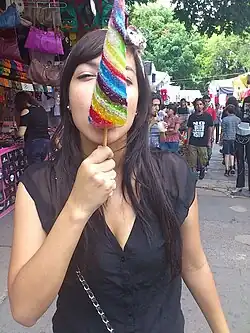Pirulín
 A Mexican woman during a festival, holding a big pirulí candy | |
| Alternative names | Pico dulce, pirulí, chupirul |
|---|---|
| Type | Confectionery |
A pirulín (also known as pirulí) is a multicolor, conic-shaped lollipop of about 10 to 15 cm long, with a sharp conical or pyramidal point, with a stick in the base, and wrapped in cellophane.
In Argentina, Colombia, and Cuba, this hard candy used to be very popular and sold in the streets and squares by a pirulinero, who are considered a form of peddlers specializing in the candy. Nowadays, it is most commonly found in certain supermarkets specializing in sweets and in a few "kioscos".
José Arechavaleta is credited with the invention of pirulí.[1][2]
Other names for pirulín:
- Bolivia: pirulo.
- Chile: pico dulce.
- Guatemala: chupete.
- Mexico: pirulí or chupirul (the latter name is a result of the success of the trademark used by Luxus).
See also
- Chupa Chups, Spanish confectionery brand
- Torrespaña, a television tower nicknamed "Pirulí" in Madrid, Spain.
- Víctor Yturbe, a Mexican singer, nicknamed "El Pirulí".
References
- ^ "Caramelo". El Correo (in Spanish). 2011-02-02. Retrieved 2025-06-13.
- ^ Frómeta Computer, Alfredo (2024-01-29). "Pirulí Cubano: A Sweet Legacy Bridging Continents". Cuba News Today. Retrieved 2025-06-13.